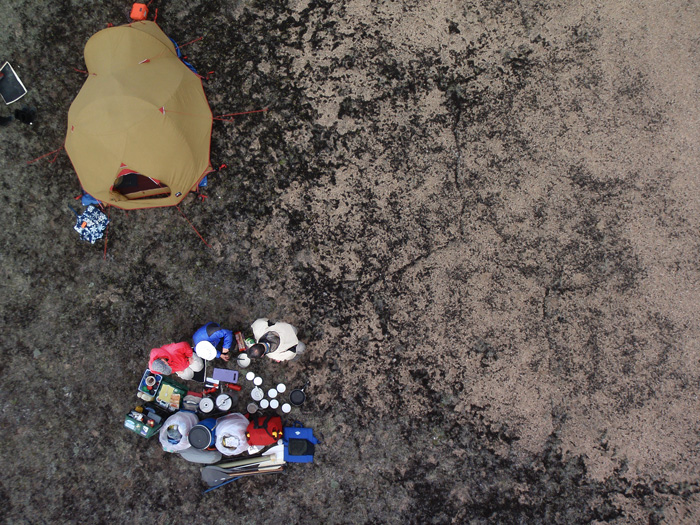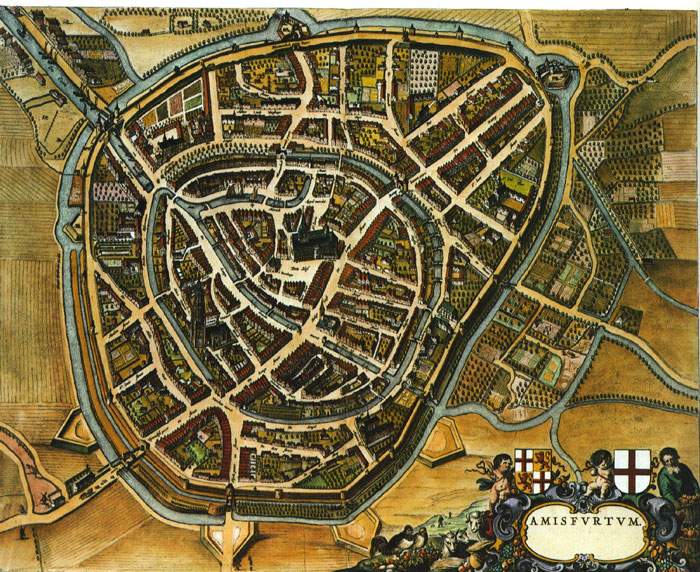Hole in the Clouds
Aug 16, 2011
 "Lee, Brian & Jeff making dinner," notes photographer Rich Durant, who snapped the picture of the men at their campsite along the Lorillard River in Nunavut. The Lorillard flows across tundra and bare rock of the billion-year-old Canadian Shield to enter Hudson Bay near the latitude of the Arctic Circle.
"Lee, Brian & Jeff making dinner," notes photographer Rich Durant, who snapped the picture of the men at their campsite along the Lorillard River in Nunavut. The Lorillard flows across tundra and bare rock of the billion-year-old Canadian Shield to enter Hudson Bay near the latitude of the Arctic Circle.
Where was Rich standing when he took this shot? It doesn't really matter; he had flown the camera up into the sky by hanging it from a kite and was using a remote control mechanism to operate the shutter while remaining safely on the ground.
The men were canoeing down the whitewater of the Lorillard; as you can see, they had stowed their gear in drysacks and waterproof boxes. The sacks and boxes don't look particularly bear-proof, however, and it's not clear what kind of arrangements they might be making to keep their food away from bears and other critters.
Whatever they were doing, it apparently didn't work out too well. The pictorial record of the expedition–called "Lorillard River Briefly"–includes photos (taken from the ground) of wolf tracks and big white bears, and then . . . a tent and foodsack trashed by something big and hungry.
Canada
aerial view
birdseye view
rock
Lorillard River
Nunavut
kite
(Image credit: Rich Durant)
Feb 26, 2012
 This was Amersfoort, Netherlands, back in the day. The city has since grown to 24 square miles, with a population of almost 150,000, but its medieval center is said to be well preserved and legally protected. Known as Boulder City, Amersfoort is now 753 years old.
This was Amersfoort, Netherlands, back in the day. The city has since grown to 24 square miles, with a population of almost 150,000, but its medieval center is said to be well preserved and legally protected. Known as Boulder City, Amersfoort is now 753 years old.
The Netherlands doesn't have very many boulders, but there used to be a big one, weighing more than nine tons, out on the moors south of town. In 1661, however, a couple of Amersfoort's leading citizens got to drinking and wagering, and then wouldn't you know it, one of them rounded up 400 neighbors to push the rock into the center of town.
The rock-pushers were rewarded with beer and pretzels, but Amersfoortians soon discovered that they really didn't much like being known far and wide as boulder draggers. They didn't like that their city's reputation was all about the stupid rock in the main square. In 1672, they buried the boulder.
More than two centuries later, in 1903, the buried rock was rediscovered and again put on display. Pranksters have moved it again from time to time, presumably with heavy equipment, but the city has now mounted its nine-ton token high on a pedestal for all the world to see.
birdseye view
rock
Netherlands
Piet Mondrian
Amersfoort
wager
antique map
Apr 10, 2012

Brittany Howard, lead singer of the Alabama Shakes, released her first CD today and played to a sold-out house last night at World Cafe in Philadelphia. I'm not a music reviewer; I won't try to describe or evaluate the performance, but I sure wouldn't quibble with the critics who have been comparing Howard to Janis Joplin, Otis Redding, James Brown, and just about every other legendary rock-soul-blues singer. She's got Brown's energy and Joplin's wail and Redding's sweetness and even a little of Hank Williams's falsetto--plus the whole history of rock and roll in the songs she writes and the licks she picks.
The rest of the band is tight and fine, but they're just along for the ride.
What do you think?
music
rock
Brittany Howard
Janis Joplin
Muscle Shoals
soul
blues
Athens, Alabama
Alabama Shakes
Apr 30, 2013

Stockholm's 110-km metro rail system has been described as one long tubular art gallery. Exposed bedrock in dozens of the stations has been painted and sculpted by a variety of artists from Sweden and beyond.
Consider this posting another entry in an occasional series: Places I've never been and stuff I've never seen and don't honestly know much of anything about, but damn.

art
Stockholm
Sweden
rock
subway
Apr 11, 2014
 This spring-break picture of Hank at the summit of the Stolen Chimney, a corkscrew spire atop the Ancient Art rockwall near Moab, Utah, has already been on Facebook, where it attracted a few comments. The award for Best Comment goes to Hank's Uncle Bob: "Get down from there this instant!"
This spring-break picture of Hank at the summit of the Stolen Chimney, a corkscrew spire atop the Ancient Art rockwall near Moab, Utah, has already been on Facebook, where it attracted a few comments. The award for Best Comment goes to Hank's Uncle Bob: "Get down from there this instant!"
mountains
tower
rock
Hank
Utah
climbing
Moab
pose
spire
Jul 21, 2014

At the north end of Castlepoint sheep station is Castle Rock itself, noted and named in the eighteenth century by Captain Cook. The rock anchors one end of a limestone reef; on the headland at the other end is Castlepoint Lighthouse, built in 1913, originally fueled by oil but now wired into the grid and controlled from a switchboard in Wellington, a couple of hours away. Its light is visible 22 miles out at sea.
The postage stamp above dates from 1947. For almost a century beginning in the 1890s, the New Zealand government operated a life insurance company that had government franking privileges and printed its own stamps. Lighthouses were nineteenth-century symbols for insurance companies (as were big rocks, e.g., Mutual of Omaha). The government sold off its insurance operations in the 1980s, to a corporation doing business as Tower Life of Dunedin, New Zealand.
The reef at Castlepoint is not at all like the coral reefs growing placidly around tropical lagoons; geologically, it's a chunk of ancient seafloor millions of years old heaved up violently during seismic activity associated with the collision of the Pacific and Australian tectonic plates.
The limestone in the reef is richly fossiliferous, and directly underneath the lighthouse it's pocked with caves.
Inside the reef is a lagoon and a wide, hard-sand beach, crucial features in the development of a large sheep station here, back in the days before highways. Since the coast in this region has no natural harbors, sheepmen used to drive wagonloads of wool bales down the beach, to be loaded at water's edge into small boats that ventured out at high tide to meet up with cargo ships waiting offshore.
Today, shipping activity at Castlepoint is mostly recreational in nature, and the hard-packed beach now serves tractors and boat trailers. The blue tractor in the picture below is driverless and remote controlled from the boat, where the captain calls for it to push an empty trailer down into the surf and then pull the loaded trailer back up to high ground.
In the picture below, the tiny figure walking the beach near water's edge is my mother-in-law.

beach
sheep
New Zealand
geology
rock
Pacific Ocean
history
Wairarapa
lighthouse
(Image credit: Little Fuji [lower photo])
 "Lee, Brian & Jeff making dinner," notes photographer Rich Durant, who snapped the picture of the men at their campsite along the Lorillard River in Nunavut. The Lorillard flows across tundra and bare rock of the billion-year-old Canadian Shield to enter Hudson Bay near the latitude of the Arctic Circle.
"Lee, Brian & Jeff making dinner," notes photographer Rich Durant, who snapped the picture of the men at their campsite along the Lorillard River in Nunavut. The Lorillard flows across tundra and bare rock of the billion-year-old Canadian Shield to enter Hudson Bay near the latitude of the Arctic Circle.





